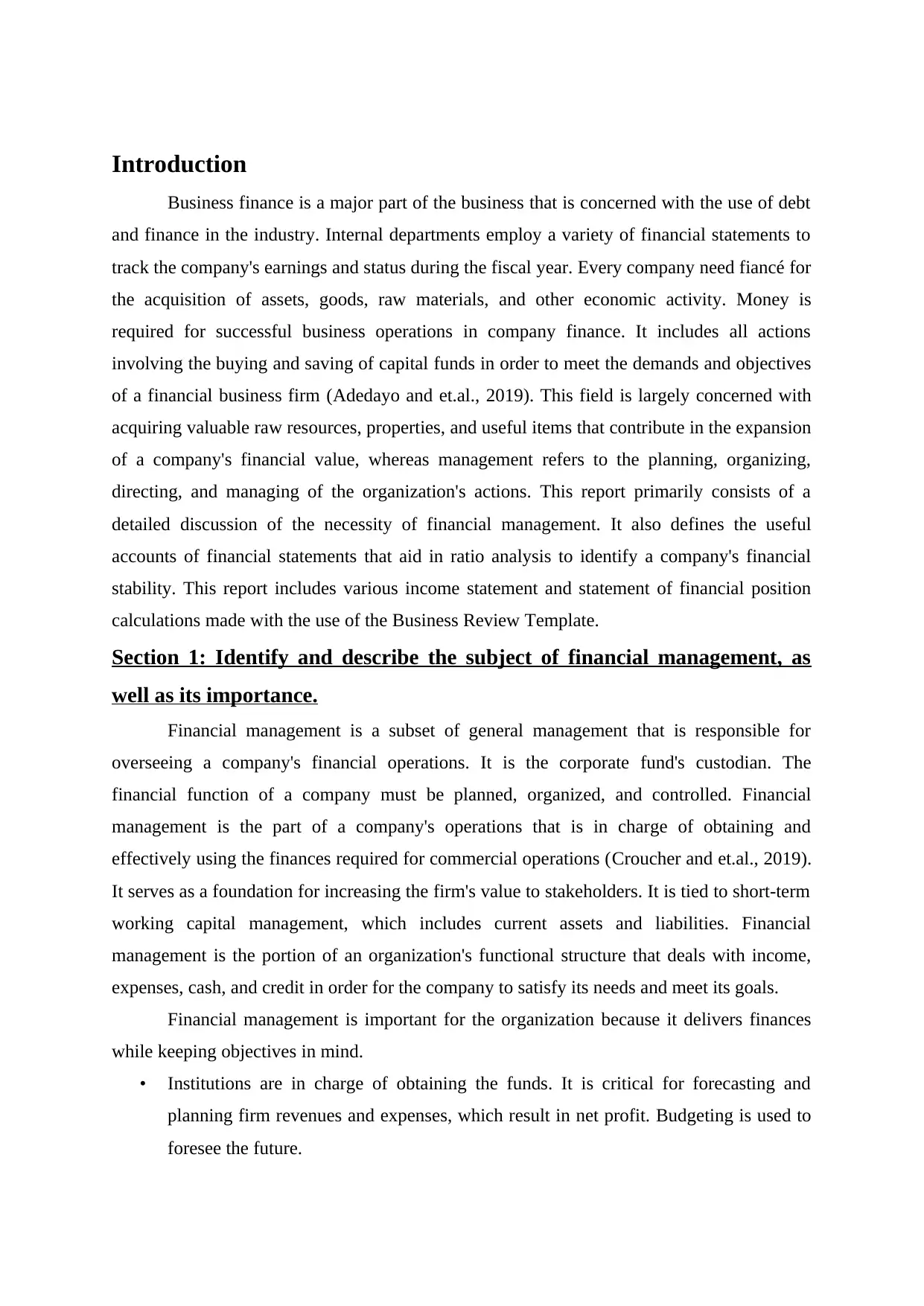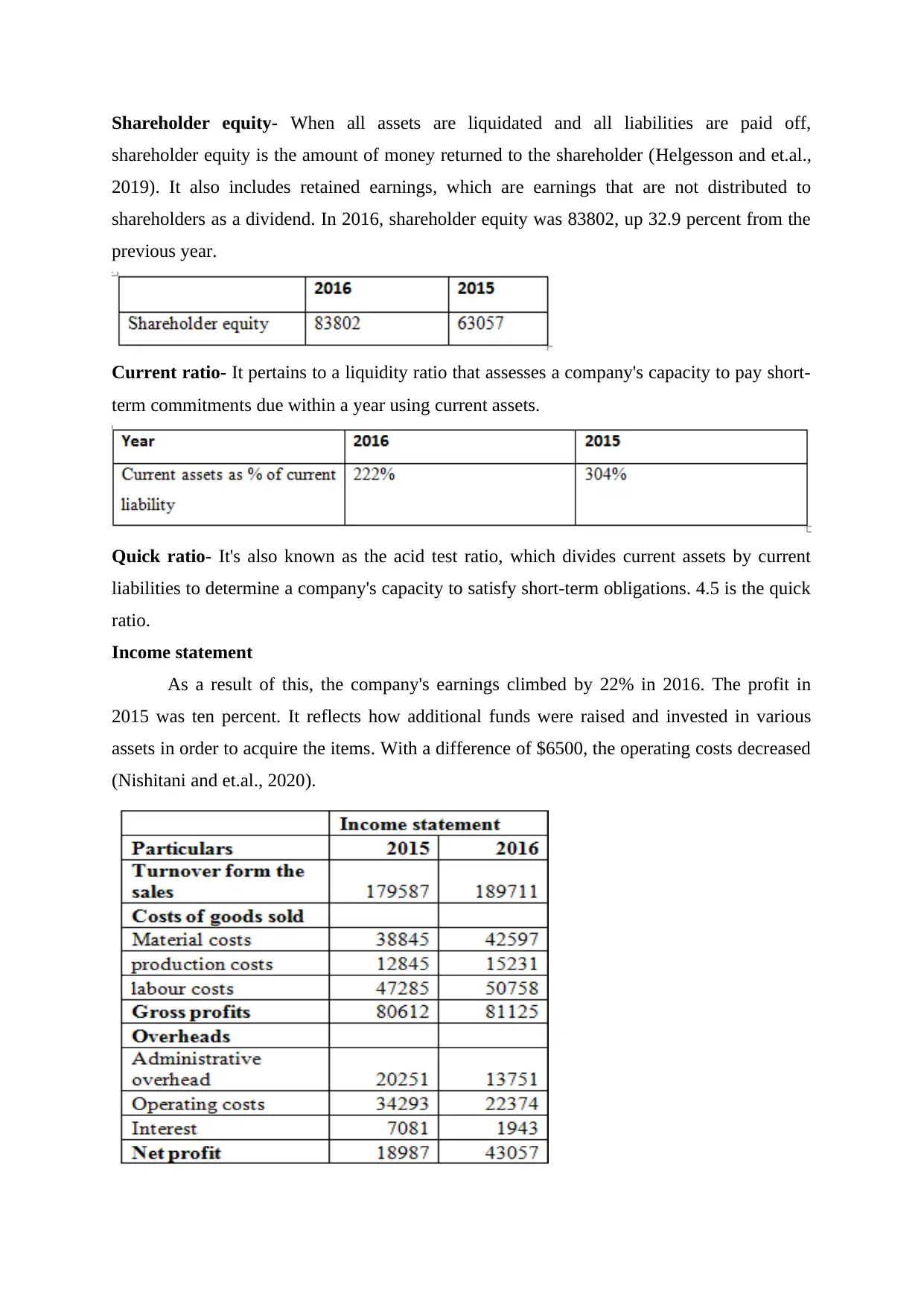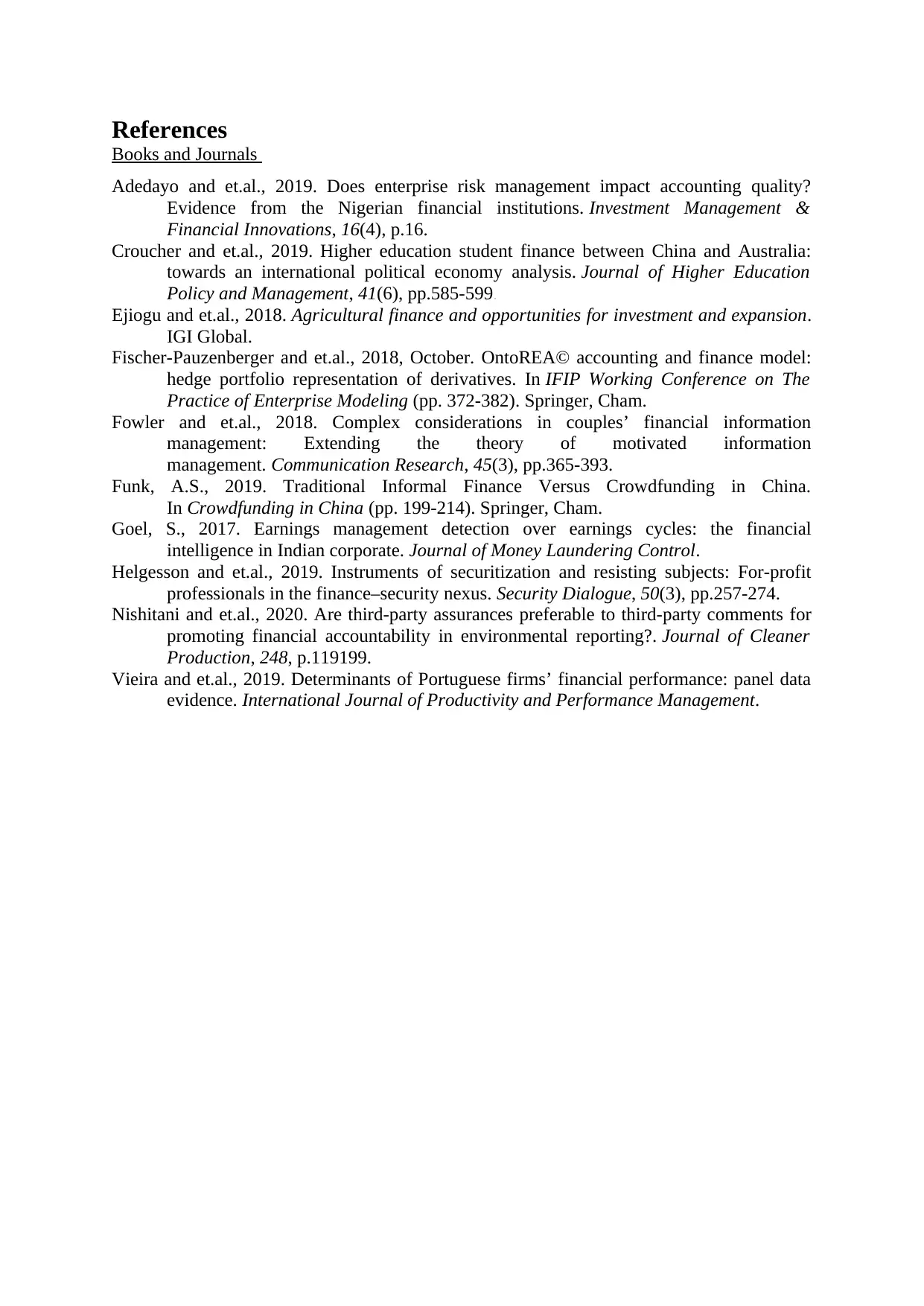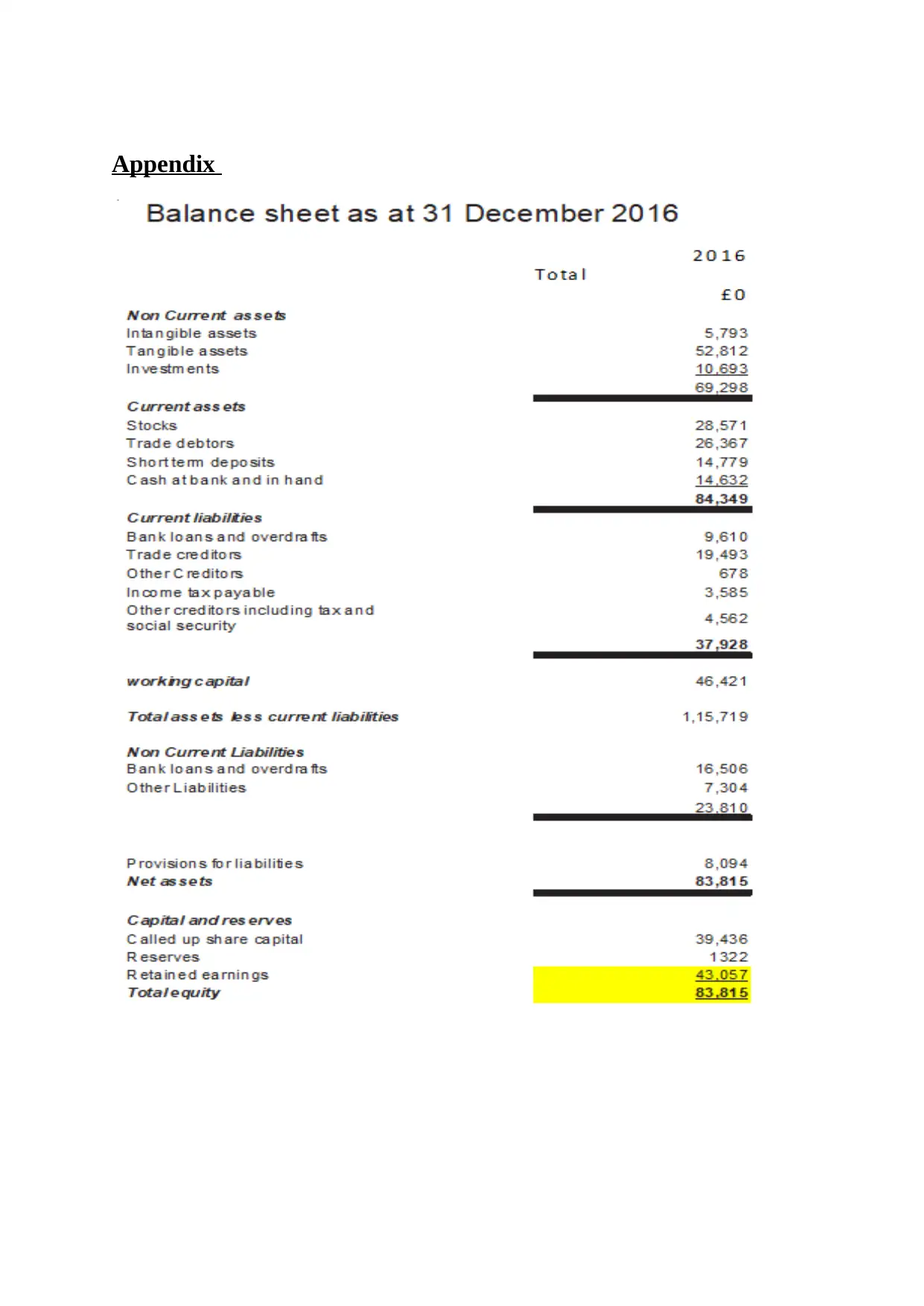Applied Business Finance: Financial Statements and Performance Review
VerifiedAdded on 2023/06/14
|11
|2589
|431
Report
AI Summary
This report provides a comprehensive analysis of applied business finance, focusing on the importance of financial management, the use of ratios, and the main financial statements. It includes a business review template with calculations of gross profit ratio, net profit ratio, shareholder equity, current ratio, and quick ratio. The report describes the profitability, liquidity, and efficiency of a company based on these ratios. Furthermore, it discusses processes a company might employ to improve its financial performance, such as consolidating debt and recovering outstanding payments, using examples from a case study. The conclusion emphasizes the critical role of finance in business growth and profitability, advocating for the evaluation of internal and external factors to enhance financial outcomes and make informed decisions based on financial data.

Applied Business Finance
Paraphrase This Document
Need a fresh take? Get an instant paraphrase of this document with our AI Paraphraser

Contents
Introduction................................................................................................................................3
Section 1: Identify and describe the subject of financial management, as well as its
importance............................................................................................................................3
Section 2: Explain the use of ratios in financial management and describe and
discuss the main financial statements.................................................................................4
Section 3 Business Review Template..................................................................................6
Section 4 Describe and discuss the processes this company might employ to improve
their financial performance using examples from the case study....................................8
Conclusion..................................................................................................................................8
Introduction................................................................................................................................3
Section 1: Identify and describe the subject of financial management, as well as its
importance............................................................................................................................3
Section 2: Explain the use of ratios in financial management and describe and
discuss the main financial statements.................................................................................4
Section 3 Business Review Template..................................................................................6
Section 4 Describe and discuss the processes this company might employ to improve
their financial performance using examples from the case study....................................8
Conclusion..................................................................................................................................8

Introduction
Business finance is a major part of the business that is concerned with the use of debt
and finance in the industry. Internal departments employ a variety of financial statements to
track the company's earnings and status during the fiscal year. Every company need fiancé for
the acquisition of assets, goods, raw materials, and other economic activity. Money is
required for successful business operations in company finance. It includes all actions
involving the buying and saving of capital funds in order to meet the demands and objectives
of a financial business firm (Adedayo and et.al., 2019). This field is largely concerned with
acquiring valuable raw resources, properties, and useful items that contribute in the expansion
of a company's financial value, whereas management refers to the planning, organizing,
directing, and managing of the organization's actions. This report primarily consists of a
detailed discussion of the necessity of financial management. It also defines the useful
accounts of financial statements that aid in ratio analysis to identify a company's financial
stability. This report includes various income statement and statement of financial position
calculations made with the use of the Business Review Template.
Section 1: Identify and describe the subject of financial management, as
well as its importance.
Financial management is a subset of general management that is responsible for
overseeing a company's financial operations. It is the corporate fund's custodian. The
financial function of a company must be planned, organized, and controlled. Financial
management is the part of a company's operations that is in charge of obtaining and
effectively using the finances required for commercial operations (Croucher and et.al., 2019).
It serves as a foundation for increasing the firm's value to stakeholders. It is tied to short-term
working capital management, which includes current assets and liabilities. Financial
management is the portion of an organization's functional structure that deals with income,
expenses, cash, and credit in order for the company to satisfy its needs and meet its goals.
Financial management is important for the organization because it delivers finances
while keeping objectives in mind.
• Institutions are in charge of obtaining the funds. It is critical for forecasting and
planning firm revenues and expenses, which result in net profit. Budgeting is used to
foresee the future.
Business finance is a major part of the business that is concerned with the use of debt
and finance in the industry. Internal departments employ a variety of financial statements to
track the company's earnings and status during the fiscal year. Every company need fiancé for
the acquisition of assets, goods, raw materials, and other economic activity. Money is
required for successful business operations in company finance. It includes all actions
involving the buying and saving of capital funds in order to meet the demands and objectives
of a financial business firm (Adedayo and et.al., 2019). This field is largely concerned with
acquiring valuable raw resources, properties, and useful items that contribute in the expansion
of a company's financial value, whereas management refers to the planning, organizing,
directing, and managing of the organization's actions. This report primarily consists of a
detailed discussion of the necessity of financial management. It also defines the useful
accounts of financial statements that aid in ratio analysis to identify a company's financial
stability. This report includes various income statement and statement of financial position
calculations made with the use of the Business Review Template.
Section 1: Identify and describe the subject of financial management, as
well as its importance.
Financial management is a subset of general management that is responsible for
overseeing a company's financial operations. It is the corporate fund's custodian. The
financial function of a company must be planned, organized, and controlled. Financial
management is the part of a company's operations that is in charge of obtaining and
effectively using the finances required for commercial operations (Croucher and et.al., 2019).
It serves as a foundation for increasing the firm's value to stakeholders. It is tied to short-term
working capital management, which includes current assets and liabilities. Financial
management is the portion of an organization's functional structure that deals with income,
expenses, cash, and credit in order for the company to satisfy its needs and meet its goals.
Financial management is important for the organization because it delivers finances
while keeping objectives in mind.
• Institutions are in charge of obtaining the funds. It is critical for forecasting and
planning firm revenues and expenses, which result in net profit. Budgeting is used to
foresee the future.
⊘ This is a preview!⊘
Do you want full access?
Subscribe today to unlock all pages.

Trusted by 1+ million students worldwide

• For decision-making, financial management delivers reliable financial reporting. It
ensures financial stability and encourages employees to save money. Financial
management aids firms in making key financial decisions.
• It aids the organization in allocating and utilizing financial resources. The efficiency
of the organization is increasing and improving. The amount of time it takes to
complete a project is reduced.
• By assuring proper use of money, financial management lowers the cost of funding.
The value of a company's stock rises as a result of financial reporting information. It
aids in the financial forecasting of funds' short- and long-term requirements (Ejiogu
and et.al., 2018).
• Financial management is critical for financial planning, which entails setting goals,
formulating financial strategies, and developing financial techniques. Financial
management assists with departmental collaboration.
• Financial management is concerned with the acquisition and preservation of capital
funds in order to meet the needs and goals of a financial business firm.
Section 2: Explain the use of ratios in financial management and describe
and discuss the main financial statements.
The financial statement is linked to the financial report that documents the company's
financial activity and condition. Government authorities, accountants, and corporations use
these statements to ensure correctness, tax financing, and investing purposes. It reflects the
financial situation and performance, which is useful in making decisions. It's in the form of a
written declaration. By having consistent and audited financial data known as annual report,
investors use financial information to analyses performance for future direction (Fischer-
Pauzenberger and et.al., 2018). It aids businesses in determining which assets provide a
benefit in order to generate long-term investments. The income statement, balance sheet, and
cash flow statement are the three elements of the statement.
• Income statement- It's also known as a profit and loss account because it shows the
revenue and costs for a given period on the company's financial statement. It depicts
the company's profitability. Aside from the balance sheet and income statement, the
revenue statement contributes in the assessment of the company's financial health. It
benefits employees by revealing the value of the company. It encompasses all
financial actions for which the corporation is responsible. It's created by comparing
two to three years' worth of data. Operating and non-operating revenue make up the
ensures financial stability and encourages employees to save money. Financial
management aids firms in making key financial decisions.
• It aids the organization in allocating and utilizing financial resources. The efficiency
of the organization is increasing and improving. The amount of time it takes to
complete a project is reduced.
• By assuring proper use of money, financial management lowers the cost of funding.
The value of a company's stock rises as a result of financial reporting information. It
aids in the financial forecasting of funds' short- and long-term requirements (Ejiogu
and et.al., 2018).
• Financial management is critical for financial planning, which entails setting goals,
formulating financial strategies, and developing financial techniques. Financial
management assists with departmental collaboration.
• Financial management is concerned with the acquisition and preservation of capital
funds in order to meet the needs and goals of a financial business firm.
Section 2: Explain the use of ratios in financial management and describe
and discuss the main financial statements.
The financial statement is linked to the financial report that documents the company's
financial activity and condition. Government authorities, accountants, and corporations use
these statements to ensure correctness, tax financing, and investing purposes. It reflects the
financial situation and performance, which is useful in making decisions. It's in the form of a
written declaration. By having consistent and audited financial data known as annual report,
investors use financial information to analyses performance for future direction (Fischer-
Pauzenberger and et.al., 2018). It aids businesses in determining which assets provide a
benefit in order to generate long-term investments. The income statement, balance sheet, and
cash flow statement are the three elements of the statement.
• Income statement- It's also known as a profit and loss account because it shows the
revenue and costs for a given period on the company's financial statement. It depicts
the company's profitability. Aside from the balance sheet and income statement, the
revenue statement contributes in the assessment of the company's financial health. It
benefits employees by revealing the value of the company. It encompasses all
financial actions for which the corporation is responsible. It's created by comparing
two to three years' worth of data. Operating and non-operating revenue make up the
Paraphrase This Document
Need a fresh take? Get an instant paraphrase of this document with our AI Paraphraser

revenue. Primary expenses incurred during the process of activities involving cost of
goods sold, selling and administrative charges, and depreciation make up the
expenses. An income statement depicts a period of time that investors and managers
use to determine if the company produced a profit or loss during that time period.
• Balance sheet- It refers to a financial statement that summarizes an individual's or
company's financial balance. It entails the assets as well as the liabilities. The balance
sheet aids in determining how obligations and new money are used to support assets.
The balance sheet is prepared once a year, at the conclusion of the accounting year,
and it shows the company's net worth (Fowler and et.al., 2018). The difference
between assets and liabilities is referred to as a company's net worth or capital.
Securities are on one side of the balance sheet, and liabilities are on the other. For the
accounting records to accurately reflect the genuine picture, both sides (liabilities and
assets) must equal (Assets = Liabilities + Equity). This is the most significant
financial document because it explains the value of time and how it is invested in a
company. Liquidity is the form of the assets. Assets, which include cash and cash
equivalents, accounts receivables, and inventories, are included in the balance sheet.
Liabilities show the order in which the corporation must pay its debts. Debt, wages
due, and dividends due are all examples of liabilities.
• Cash flow statement- It describes the impact of changes in the balance sheet and
income on cash and cash equivalents. It specifies how much money comes in and
goes out of the company. The cash flow statement divides the facts from the
company's accounting records into three categories: financial expenses, investment
activities, and funding operations. The goal of this statement is to inform investors
about how the company's operations are running and where the funds are coming
from and how they are being spent. Operating activities, investing activities, and
financing activities are split into three sections (Funk, A.S., 2019). The sources and
uses of finances for performing commercial activities and selling products or services
are known as operating activities. The sources and uses of cash from firm investments
for the long-term future are included in the investing activities. The transactions
involved in long-term labilities, owners’ equity and change to short-term borrowings
are included in financing activities.
Use of ratio in financial management
The external analysts utilize financial ratios to determine the components of business
that indicate the company's profitability, liquidity, and solvency. It is the process of analyzing
goods sold, selling and administrative charges, and depreciation make up the
expenses. An income statement depicts a period of time that investors and managers
use to determine if the company produced a profit or loss during that time period.
• Balance sheet- It refers to a financial statement that summarizes an individual's or
company's financial balance. It entails the assets as well as the liabilities. The balance
sheet aids in determining how obligations and new money are used to support assets.
The balance sheet is prepared once a year, at the conclusion of the accounting year,
and it shows the company's net worth (Fowler and et.al., 2018). The difference
between assets and liabilities is referred to as a company's net worth or capital.
Securities are on one side of the balance sheet, and liabilities are on the other. For the
accounting records to accurately reflect the genuine picture, both sides (liabilities and
assets) must equal (Assets = Liabilities + Equity). This is the most significant
financial document because it explains the value of time and how it is invested in a
company. Liquidity is the form of the assets. Assets, which include cash and cash
equivalents, accounts receivables, and inventories, are included in the balance sheet.
Liabilities show the order in which the corporation must pay its debts. Debt, wages
due, and dividends due are all examples of liabilities.
• Cash flow statement- It describes the impact of changes in the balance sheet and
income on cash and cash equivalents. It specifies how much money comes in and
goes out of the company. The cash flow statement divides the facts from the
company's accounting records into three categories: financial expenses, investment
activities, and funding operations. The goal of this statement is to inform investors
about how the company's operations are running and where the funds are coming
from and how they are being spent. Operating activities, investing activities, and
financing activities are split into three sections (Funk, A.S., 2019). The sources and
uses of finances for performing commercial activities and selling products or services
are known as operating activities. The sources and uses of cash from firm investments
for the long-term future are included in the investing activities. The transactions
involved in long-term labilities, owners’ equity and change to short-term borrowings
are included in financing activities.
Use of ratio in financial management
The external analysts utilize financial ratios to determine the components of business
that indicate the company's profitability, liquidity, and solvency. It is the process of analyzing

financial data utilizing a company's financial statement. The ratio analyses are used to
compare the company's financial performance. It helps the organization make better decisions
about its position. By gathering data from financial statements and directing future
performance, the usage of ratios also states the trend line of financial performance. Financial
ratios can be used to examine how a company's profitability has changed over time, and they
can also be used to create market reports that span a wide range of income statements (Goel,
S., 2017). This provides a better understanding of service users, encouraging staff to keep a
positive perspective on the company's culture and giving them various advantages in
appraising production. This is how trend analysts quantify their efficiency using several
financial criteria. The trend line summarizes financial success by combining information
from financial statements and predicting future results. It's also used to figure out how
efficient a company's asset and liability management.
Section 3 Business Review Template
Gross profit ratio- The company efficiency and performance are measured by dividing
profit from total sales.
Net profit ratio- It's also known as net income, which is profit as a percentage of revenue. In
2016, the net profit climbed by 23 percent.
compare the company's financial performance. It helps the organization make better decisions
about its position. By gathering data from financial statements and directing future
performance, the usage of ratios also states the trend line of financial performance. Financial
ratios can be used to examine how a company's profitability has changed over time, and they
can also be used to create market reports that span a wide range of income statements (Goel,
S., 2017). This provides a better understanding of service users, encouraging staff to keep a
positive perspective on the company's culture and giving them various advantages in
appraising production. This is how trend analysts quantify their efficiency using several
financial criteria. The trend line summarizes financial success by combining information
from financial statements and predicting future results. It's also used to figure out how
efficient a company's asset and liability management.
Section 3 Business Review Template
Gross profit ratio- The company efficiency and performance are measured by dividing
profit from total sales.
Net profit ratio- It's also known as net income, which is profit as a percentage of revenue. In
2016, the net profit climbed by 23 percent.
⊘ This is a preview!⊘
Do you want full access?
Subscribe today to unlock all pages.

Trusted by 1+ million students worldwide

Shareholder equity- When all assets are liquidated and all liabilities are paid off,
shareholder equity is the amount of money returned to the shareholder (Helgesson and et.al.,
2019). It also includes retained earnings, which are earnings that are not distributed to
shareholders as a dividend. In 2016, shareholder equity was 83802, up 32.9 percent from the
previous year.
Current ratio- It pertains to a liquidity ratio that assesses a company's capacity to pay short-
term commitments due within a year using current assets.
Quick ratio- It's also known as the acid test ratio, which divides current assets by current
liabilities to determine a company's capacity to satisfy short-term obligations. 4.5 is the quick
ratio.
Income statement
As a result of this, the company's earnings climbed by 22% in 2016. The profit in
2015 was ten percent. It reflects how additional funds were raised and invested in various
assets in order to acquire the items. With a difference of $6500, the operating costs decreased
(Nishitani and et.al., 2020).
shareholder equity is the amount of money returned to the shareholder (Helgesson and et.al.,
2019). It also includes retained earnings, which are earnings that are not distributed to
shareholders as a dividend. In 2016, shareholder equity was 83802, up 32.9 percent from the
previous year.
Current ratio- It pertains to a liquidity ratio that assesses a company's capacity to pay short-
term commitments due within a year using current assets.
Quick ratio- It's also known as the acid test ratio, which divides current assets by current
liabilities to determine a company's capacity to satisfy short-term obligations. 4.5 is the quick
ratio.
Income statement
As a result of this, the company's earnings climbed by 22% in 2016. The profit in
2015 was ten percent. It reflects how additional funds were raised and invested in various
assets in order to acquire the items. With a difference of $6500, the operating costs decreased
(Nishitani and et.al., 2020).
Paraphrase This Document
Need a fresh take? Get an instant paraphrase of this document with our AI Paraphraser

Describing the profitability, liquidity and efficiency of the company
The profitability ratio assesses a company's capacity to generate profit while incurring
expenses. A high profit margin indicates that a company's performance has improved. The
return on equity ratio, return on assets, profit and gross margin, and return on capital
employed are among the ratios. The liquidity ratio assesses a company's capacity to satisfy its
obligations with current assets. When a company's assets are insufficient to cover its debts,
the company's assets are turned into cash (Vieira and et.al., 2019). The cash ratio, quick ratio,
and current ratio are all included. The efficiency ratio calculates how efficiently a company's
assets and liabilities are used to generate sales and profits. It entails inventory calculations,
machine use, and liability turnover.
Section 4 Describe and discuss the processes this company might employ to
improve their financial performance using examples from the case study.
• Consolidate debt- The examining existing corporate debt is crucial when considering
ways to improve a company's finances. Consolidating their debts may be a good
choice if they have a lot of them. It is also easier and more cost-effective to refinance
the mortgage into a single payment. Do some investigation and weigh your options
before agreeing to a new contract.
• Recover outstanding payments- The Unpaid bills have an impact on the company's
financial performance and cash flow. A debt collection policy can be employed in this
situation by reminding debtors of their commitments on a regular basis. When
drafting purchase agreements, make sure the terms are clear about when refunds are
expected and what happens if they aren't received on time.
Conclusion
From above this can be concluded that Finance, it has been decided, is the lifeblood of
business, assisting in the company's growth and profitability. The effects of financial
management on sales, profitability, and the state of corporate accounting. The corporation
should evaluate the many external and internal aspects in the organization to improve
financial performance. These studies aid ratio research, even though the elements employed
in profitability are collected from financial records. Financial statements assist in analyzing
actual costs, earnings, revenues, commitments, and properties throughout the course of an
accounting year, enabling for better educated competition decisions.
The profitability ratio assesses a company's capacity to generate profit while incurring
expenses. A high profit margin indicates that a company's performance has improved. The
return on equity ratio, return on assets, profit and gross margin, and return on capital
employed are among the ratios. The liquidity ratio assesses a company's capacity to satisfy its
obligations with current assets. When a company's assets are insufficient to cover its debts,
the company's assets are turned into cash (Vieira and et.al., 2019). The cash ratio, quick ratio,
and current ratio are all included. The efficiency ratio calculates how efficiently a company's
assets and liabilities are used to generate sales and profits. It entails inventory calculations,
machine use, and liability turnover.
Section 4 Describe and discuss the processes this company might employ to
improve their financial performance using examples from the case study.
• Consolidate debt- The examining existing corporate debt is crucial when considering
ways to improve a company's finances. Consolidating their debts may be a good
choice if they have a lot of them. It is also easier and more cost-effective to refinance
the mortgage into a single payment. Do some investigation and weigh your options
before agreeing to a new contract.
• Recover outstanding payments- The Unpaid bills have an impact on the company's
financial performance and cash flow. A debt collection policy can be employed in this
situation by reminding debtors of their commitments on a regular basis. When
drafting purchase agreements, make sure the terms are clear about when refunds are
expected and what happens if they aren't received on time.
Conclusion
From above this can be concluded that Finance, it has been decided, is the lifeblood of
business, assisting in the company's growth and profitability. The effects of financial
management on sales, profitability, and the state of corporate accounting. The corporation
should evaluate the many external and internal aspects in the organization to improve
financial performance. These studies aid ratio research, even though the elements employed
in profitability are collected from financial records. Financial statements assist in analyzing
actual costs, earnings, revenues, commitments, and properties throughout the course of an
accounting year, enabling for better educated competition decisions.

References
Books and Journals
Adedayo and et.al., 2019. Does enterprise risk management impact accounting quality?
Evidence from the Nigerian financial institutions. Investment Management &
Financial Innovations, 16(4), p.16.
Croucher and et.al., 2019. Higher education student finance between China and Australia:
towards an international political economy analysis. Journal of Higher Education
Policy and Management, 41(6), pp.585-599.
Ejiogu and et.al., 2018. Agricultural finance and opportunities for investment and expansion.
IGI Global.
Fischer-Pauzenberger and et.al., 2018, October. OntoREA© accounting and finance model:
hedge portfolio representation of derivatives. In IFIP Working Conference on The
Practice of Enterprise Modeling (pp. 372-382). Springer, Cham.
Fowler and et.al., 2018. Complex considerations in couples’ financial information
management: Extending the theory of motivated information
management. Communication Research, 45(3), pp.365-393.
Funk, A.S., 2019. Traditional Informal Finance Versus Crowdfunding in China.
In Crowdfunding in China (pp. 199-214). Springer, Cham.
Goel, S., 2017. Earnings management detection over earnings cycles: the financial
intelligence in Indian corporate. Journal of Money Laundering Control.
Helgesson and et.al., 2019. Instruments of securitization and resisting subjects: For-profit
professionals in the finance–security nexus. Security Dialogue, 50(3), pp.257-274.
Nishitani and et.al., 2020. Are third-party assurances preferable to third-party comments for
promoting financial accountability in environmental reporting?. Journal of Cleaner
Production, 248, p.119199.
Vieira and et.al., 2019. Determinants of Portuguese firms’ financial performance: panel data
evidence. International Journal of Productivity and Performance Management.
Books and Journals
Adedayo and et.al., 2019. Does enterprise risk management impact accounting quality?
Evidence from the Nigerian financial institutions. Investment Management &
Financial Innovations, 16(4), p.16.
Croucher and et.al., 2019. Higher education student finance between China and Australia:
towards an international political economy analysis. Journal of Higher Education
Policy and Management, 41(6), pp.585-599.
Ejiogu and et.al., 2018. Agricultural finance and opportunities for investment and expansion.
IGI Global.
Fischer-Pauzenberger and et.al., 2018, October. OntoREA© accounting and finance model:
hedge portfolio representation of derivatives. In IFIP Working Conference on The
Practice of Enterprise Modeling (pp. 372-382). Springer, Cham.
Fowler and et.al., 2018. Complex considerations in couples’ financial information
management: Extending the theory of motivated information
management. Communication Research, 45(3), pp.365-393.
Funk, A.S., 2019. Traditional Informal Finance Versus Crowdfunding in China.
In Crowdfunding in China (pp. 199-214). Springer, Cham.
Goel, S., 2017. Earnings management detection over earnings cycles: the financial
intelligence in Indian corporate. Journal of Money Laundering Control.
Helgesson and et.al., 2019. Instruments of securitization and resisting subjects: For-profit
professionals in the finance–security nexus. Security Dialogue, 50(3), pp.257-274.
Nishitani and et.al., 2020. Are third-party assurances preferable to third-party comments for
promoting financial accountability in environmental reporting?. Journal of Cleaner
Production, 248, p.119199.
Vieira and et.al., 2019. Determinants of Portuguese firms’ financial performance: panel data
evidence. International Journal of Productivity and Performance Management.
⊘ This is a preview!⊘
Do you want full access?
Subscribe today to unlock all pages.

Trusted by 1+ million students worldwide

Appendix
Paraphrase This Document
Need a fresh take? Get an instant paraphrase of this document with our AI Paraphraser

1 out of 11
Related Documents
Your All-in-One AI-Powered Toolkit for Academic Success.
+13062052269
info@desklib.com
Available 24*7 on WhatsApp / Email
![[object Object]](/_next/static/media/star-bottom.7253800d.svg)
Unlock your academic potential
Copyright © 2020–2025 A2Z Services. All Rights Reserved. Developed and managed by ZUCOL.



